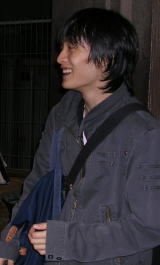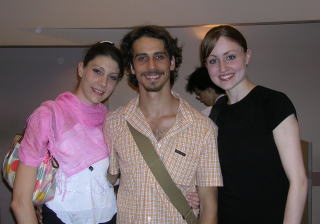NEWS 2004
Home
14 December 2004
I have just watched the program about John Neumeier, "the world of
John Neumeier". It consists of John Neumeier's interview and his choreographed
ballet scenes. The ballet scenes in the program were from the Ballet-Tage
of this year.
There are 10 chapters which include prologue and epilogue.
Prologue - The core of facinating..... is something from psychological expression. "Die Kamekiendame" as an example.
Chapter 1 - Birth of a choreographer......"Haiku" from the workshop.
Chapter 2 - Literary works adapted for ballet......"Romeo and Juliet"
Chapter 3 - Renewal of classical ballet......"The Nutscraker",
"Illusion-like Swan Lake", "Sleeping Beauty"
Chapter 4 - The way to symphonic ballet......."The third of Gustav
Mahler"
Chapter 5 - Religious Ballet......."Matthaeus Passion", "Dona
Nobis Pacem(Messaia, Requiem)
Chapter 6 -
Chapter 7 -
Chapter 8 -
Epilogue - A message of Love
I will describe later.
(S)
27 November 2004
Helene Bouchet got Dr. Wilhelm Oberdoerffer-Preis of this year. Congraturations
Helene!!!
9 November 2004
I have heard the news that Silvia Azzoni and Alexandre Riabko are going
to perform on the premiere of La Fille mal gardee before. And I have just
heard the news that Kevin Haigen is going to dance the role of Widow Simone
!!!!!!!! Oh, I cannot see his performance, no, no, I will not be able to
see his performance, but I would love to see that!!! I am panicked to hear
that.
Would you please give your impression on my guestbook(Let's Talk) if you
see the performance of the premiere?
Of course, I am very interested in the second day's cast - Anna Polikarpova,
Carsten Jung and Lloyd Riggins.
13 September 2004
One of my friends K told me the website(http://64.139.175.204/event/yuh/) of the photos which were taken in Sapporo, Japan on 30 August 2004. Whose?
Jiri and Otto as well as Marie-Agnes Gillot(Paris Opera Ballet Company, etoile) were dancing the work choreographed by Jiri.
8 September 2004
Dancing through a mystery in black and white(By Zai Sethna) from Daily Yomiuri
It's cetainly not unheard of in the dance world for different choreographers
to give different spins to adaptations of classic works of fiction, but
Banjo no Teki may be the first to pair up two completely different adaptations of the
same work in a single production.
Based on a mystery novel of the same name by Kaoru Kitamura, the production
is the brainchild of Theatre Drama City, which had the smarts to hire two
completely different choreographers-Yukichi Hattori and Yukio Ueshima-to
bring their visions to the work. While Hattori, best known as a prodigious
soloist of the Hamburg Ballet Company, approaches his workfrom a very thematic
perspective, Ueshima incorporates narratives into even the most complex
of his works.
It may be surprising to learn, however, that it was the 23-year-old Hattori,
who only recently branched into choreography, who selected the work to
base the production on and not the far more experianced Ueshima.
"(Theatre Drama City) asked me to create a ballet piece based on a
written work, and I just happened to have Banjo no Teki with me at the time," Hattori said, "I started reading it, keeping
in mind that I was going to adapt it for the stage, and images and structural
ideas immediately began popping up in my head."
This seemingly random choice turned out to be quite inspired Kitamura sets
up the story-in which a man tries to negotiate for release of his wife
with the man holding her hostage-like a game of chess, with the four main
characters(one is integral to a twist that comes in later) represented
as the two queens and kings.
The husband and wife represented "white," but as the story moves
along, the line between who represents which color becomes blurred-in fact,
the book's shocking finale has reportedly made many readers feel very uncomfortable.
This is, in fact, exactly the kind of moral ambiguity that Hattori has
explored often in his dancework, including his acclaimed turn as Stanislav
in the Hamburg Ballet's production of Nijinsky. "Your 'color' being different has to do with how you live your life
and how you look at the things around you," Hattori says, "It
has nothing to do with good and evil. That is something the people around
you decide on."
He added the book made him come to the conclusion that, if observed objectively,
even an act like murder is nothing but a choice, and it being labeled as
good or evil is simply a result of that action.
"For example, say you were bullied a lot or one of your parents was
killed by someone else. That creates the possibility that you might kill
the perpetrator. Everyone is capable of becoming 'black,' so why do we
judge people simply based on these actions?"
Hattori and three of his friends from thr Hamburg Ballet who are participating
with the blessings of the company-will each play one of the characters,
but only symbolically, to express what he believes are the themes of the
story.
In contrast, Ueshima has challenged himself to re-create the narrative
of the book through dance.
"Each chapter of the book begins with something like, 'The black king
makes his move,' or 'The white queen does such and such,' and that made
me realize the story's played out like a big chess game," he said.
"So I'll have the dancers representing by the characters try to take
over each other's space to show which side is winning . But as two sides
continue to attempt to seize space from each other, they end up winning
nothing."
He added that the two sides would be represented by the dance forms he
believes symbolizes them. For example, the white queen will be played by
an elegant ballet dancer, while the black queen will be played by a less
stylized comtemporary dancer.
But Ueshima's unique style, created natural progression from his studying
many differenrt dance forms without sticking to a sigle one, will quite
possibly lead to something more.
"I think it would be interesting to have these dance forms blend with
each other toward the end of the story," he said. "Yukichi said
about the book, in the end, everything's gray. That's exactly it. White
and Black repeatedly attack each other, and by the end they've blended
into each other into a gray."
Despite not nothing discussed their approaches in detail to each other,
the two choreographers have come up with works that are remarkably similar.
Hattori himself remarked that he was surprised when watching Ueshima's
dancers rehearse that some of the movements and themes expressed were very
similar to that of his own piece.
In accordance with the theme of the production, the two pieces have been
separated into White(Hattori's) and Black(Ueshima's). This could just be
a marketing ploy, but more likely than not, it's a way to drive home the
point that in dance, or art for that matter, there is no right or wrong
approach to adapting a particular subject, because the best works resound
with the same universal truths.
6 September 2004
I knew Adela Pollertova went back home to Plague, but I could not ask her
what she would do there. According to Hamburg Abendblatt, she is going to be a journalist. Hurrah Adela !!!
29 August 2004
The work "Banjo no Teki(The Player on the Other Side)" choreographed
by Yukichi Hattori was so fascinating. I was much moved. What he wanted
to express about this performance appealed me so much.
I'll illustrate a little.
There are four persons, a white queen(Helene Bouchet), a white king(Yukichi
Hattori), a black queen(Galien Johnston), and a black king(Yohan Stegli).
The former two seem to symbolize a good will, the latter two, a bad will.
The black queen absurdly illtreat the white queen with the black king.
The white king tries to rescue the white queen. They battle violently.
Then the black persons die. After that the heart of the white queen, however,
is destroyed. It seems that it is hard to redeem her mind. But at last
the fervent dance of the white king succeeds to save her mind.
Hattori did not express as simple dualism of "good" and "bad".
He realizes there is a good will in a bad will, and a good will finds a
bad will in its mind. Therefore the heart of the white queen kills herself,
I think that Hattori does. Helene Bouchet, Yohan Stegli and Galien Johnston
performed wonderfully as well as Hattori.
The first scene of Yohan and Galien was beautiful thrillingly. Above that
Helene's dance was pure and innocent so that the audience was impressed
by her performance. To my regret, the music was not suitable for the dance.
I wish Hamburg people will see this Hattori's work. It is sehr schoen !!!!!
 Yukichi Hattori at the backstage door in Hamburg on 24 June
Yukichi Hattori at the backstage door in Hamburg on 24 June
 In Osaka(Japan) after the performance of Banjo no Teki on 21 June
In Osaka(Japan) after the performance of Banjo no Teki on 21 June
Helene Bouchet, Yohan Stegli, Galien Johnston(left to right)
8 August 2004
The Yukichi's TV program was so fantastic ! The content was Yukichi's
dance, his intrview, his rehearsal, Mr. Neumeier's interview, a little
bit of the performance of Winterreise on the stage and so on. The broadcasting
of Winterreise was clear and wunderbar ! I wish the DVD(or video) is
published as soon as possible.
14 July 2004
The TV program about Yukichi Hattori is to be broardcasted at 11:15 p.m.
next Sunday(18 July). The title of the program is "Jonetsu Tairiku",
so-called "Land of Passion". You can watch the preview of this
program at the following web site.
http://mbs.jp/jyonetsu/index2.html(closed)
In addition to that, you can also see a little bit of making video of Hattori's choreographic work"Banjo no Teki"(written by Kaoru Kitamura), so-called "The Player on the Other Side"(the same title of the mystery by Ellery Queen). The web site is as follows:
http://homepage.mac.com/keihin315/YukichiHattori/iMovieTheater26.html(closed)
I will report about the both as soon as possible.
(S)
 Yukichi Hattori at the backstage door in Hamburg on 24 June
Yukichi Hattori at the backstage door in Hamburg on 24 June In Osaka(Japan) after the performance of Banjo no Teki on 21 June
In Osaka(Japan) after the performance of Banjo no Teki on 21 June